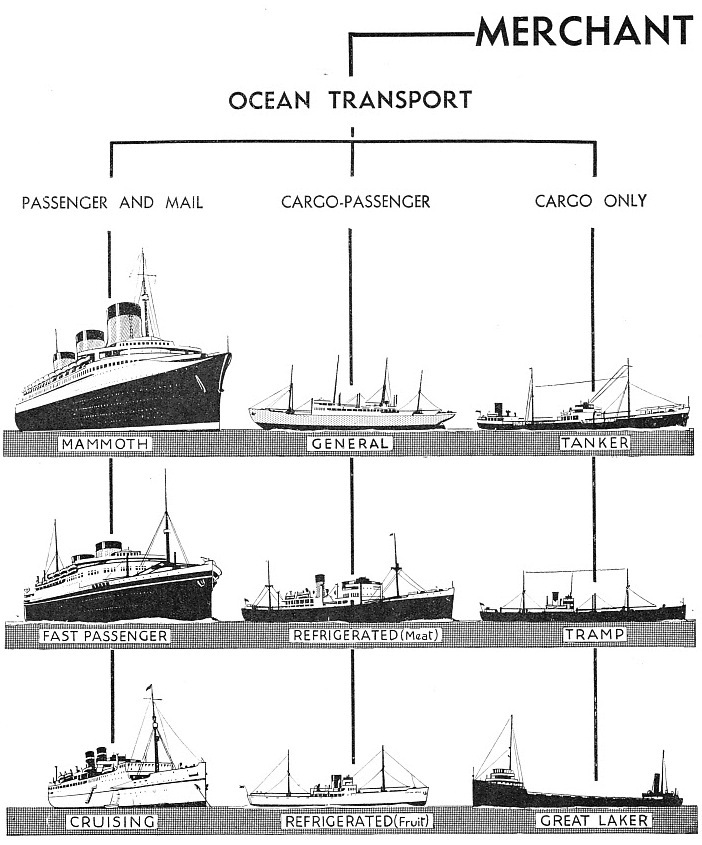

© Shipping Wonders of the World 2012-

Merchant Ship Types
OCEAN TRANSPORT

Normandie (French Line) may be taken as a typical mammoth transatlantic vessel (top left). Since all these silhouettes are approximately to scale, the enormous size of Normandie can be appreciated. Her 79,250 gross tons and 160,000 hp are impressive compared with the Fast Passenger Vessel, the Cunard White Star Georgic. She, too, is a transatlantic ship, but of 20,000 hp and nearly 28,000 gross tons.
The graceful proportions of the Cruising Liner Arandora Star (Blue Star Line) account for only 14,694 gross tons. Arandora Star was originally designed as a meat-
The cargo and passenger vessels have similar dimensions. The General Cargo Ship illustrated, which has a hull of specially patented design, is of the type with a gross tonnage exceeding 8,400 and a horse-
The Refrigerated Meat Ship has a gross tonnage of approximately 8,500 and a total of 1,500 h.p., with twin screws.
The Fruit Ship illustrated is remarkable for her speed, having over 16 knots, although her tonnage approximates only 3,600 gross, with engines of nearly 4,000 h.p.
The Tanker illustrated here has a carrying capacity of about 10,000 tons and nearly 3,000 hp. The modern Tramp carries 9,000 tons and has a speed of II knots, with about 2,000 h.p. on a single screw.
The Great Laker does not belong to ocean transport, except by reason of size and power. This ship type operates as a cargo vessel on the enormous freshwater areas of North America, and has a length of 579 ft, a carrying capacity of about 12,000 tons, a single screw, and not less than 3,000 hp. Occasionally Great Lakers sail out into the open sea.
SEA TRANSPORT

Sea Transport types in the passenger category include Cross-
The Paddle Passenger Vessel is a familiar feature of the Clyde and of many seaside resorts. In size a vessel of this type is between the Cross-
The Passenger Cargo Coaster carries, in addition to a number of passengers in luxurious quarters, nearly 1,500 tons of cargo. Such vessels have twin screws driven by engines of 1,250 hp, and are comparatively a new ship type.
The Collier carries cargoes from the British coal-
The Baltic Trader works from the Swedish ports. She has a special stem for ice-
Cable Ships are large seaworthy vessels, yacht-
The Trawler illustrated is capable of travelling as far north as Iceland. She has about 800 hp.
The Tug, an important unit of subsidiary transport, is typical of vessels employed for docking and undocking ships. She is a sturdy vessel of about 1,000 hp. Large ships need the assistance of tugs at every port.
You can read more on “Merchant Ship Types”, “Refrigerated Ships” and
“World’s Largest Ships” on this website.